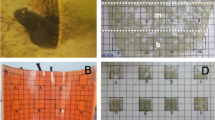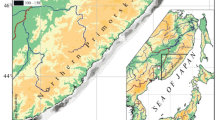Abstract
Telmatochromis vittatus (Cichlidae) is a Tanganyikan substrate brooder which spawns in the gastropod-shell nests of a cichlid, Lamprologus callipterus. We describe male reproductive tactics of T. vittatus in and around the shell nests, where males of various sizes were found. Based on utilization patterns of the shell nests, interactions among males, and spawning behaviors, males could be categorized into four types based on reproductive tactics and in order of body size: sneaker males, satellite males, territorial males and piracy males. Size range of males in tactic groups rarely overlapped. Territorial males defended shell nests harboring multiple females, but during pair-spawning they were occasionally taken over by large piracy males that visited several nests repeatedly. Small sneaker males darted to pair-spawning territorial males and might ejaculate sperm. Satellite males did not perform parasitic spawning but pair-spawned in a single shell outside the nests. Spawning of satellite males was infrequently parasitized. The largest gonado-somatic index (GSI) was found in sneaker males followed by piracy males, territorial males and satellite males, suggesting that gonadal investment of males using the four tactics may be consistent with intensity or risk of sperm competition.



Similar content being viewed by others
References
Alonzo SH (2004) Uncertainty in territory quality affects the benefits of usurpation in a Mediterranean wrasse. Behav Ecol 15:278–285
Alonzo SH, Warner RR (2000) Allocation to male guarding or increased sperm production in Mediterranean wrasse. Am Nat 156:266–275
Awata S, Munehara H, Kohda M (2005) Social system and reproduction of helpers in the cooperatively breeding cichlid fish (Julidochromis ornatus) in Lake Tanganyika: field observations and parentage analyses. Behav Ecol Sociobiol (in press)
van den Berghe E (1988) Piracy as an alternative reproductive tactic for males. Nature 334:697–698
van den Berghe E (1992) Parental care and the cost of reproduction in a Mediterranean fish. Behav Ecol Sociobiol 30:373–378
Candolin U, Voight HR (2003) Size-dependent selection on arrival times in sticklebacks: Why small males arrive first. Evolution 57:862–871
Dierkes P, Taborsky M, Kohler U (1999) Reproductive parasitism of broodcare helpers in a cooperative breeding fish. Behav Ecol 10:510–515
Forsgren E (1997) Female sand gobies prefer good fathers over dominant males. Proc R Soc Lond Biol B 264:1283–1286
Hoelzer G (1990) Male-male competition and female choice in the Cortez damselfish, Stegastes rectifraenum. Anim Behav 40:339–349
Keenleyside MHA (1991) Cichlid fishes behaviour, ecology and evolution. Chapman & Hall, London
Kuwamura T (1997) The evolution of parental care and mating systems among Tanganyikan cichlids. In: Kawanabe H, Hori M, Nagoshi M (eds) Fish communities in Lake Tanganyika. Kyoto University Press, Kyoto, pp 57–86
Mboko SK, Kohda M (1999) Description of piracy mating in a monogamous substrate breeding cichlid in Lake Tanganyika. J Ethol 17:51–55
Neff BD, Fu P, Gross MR (2003) Sperm investment and alternative mating tactics in bluegill sunfish (Lepomis macrochirus). Behav Ecol 14:634–641
Okuda N, Yanagisawa Y (1996) Filial cannibalism by mouthbrooding males of the cardinal fish, Apogon doederleini, in relation to their physical condition. Env Biol Fish 45:397–404
Parker GA (1982) Why are there so many tiny sperm? Sperm competition and the maintenance of two sexes. J Theor Biol 96:281–294
Parker GA (1990a) Sperm competition games: raffles and roles. Proc R Soc Lond Biol B 242:120–126
Parker GA (1990b) Sperm competition games: sneaks and extra-pair copulations. Proc R Soc Lond Biol B 242:127–133
Parker GA (1993) Sperm competition games: sperm size and sperm number under adult control. Proc R Soc Lond Biol B 253:245–254
Parker GA, Ball MA, Stockley P, Gage MJG (1997) Sperm competition games: a prospective analysis of risk assessment. Proc R Soc Lond Biol B 263:1291–1297
Petersen CW, Warner RR (1998) Sperm competition in fishes. In: Birkhead TR, Møller AP (eds) Sperm competition and sexual selection. Academic Press, San Diego, pp 435–463
Rice WR (1989) Analyzing tables of statistical tests. Evolution 43:223–225
Rowland WJ (1989) The effects of body size aggression and nuptial coloration on competition for territories in male threespine sticklebacks Gasterosteus aculeatus. Anim Behav 37:282–289
Sato (1994) Active accumulation of spawning substrate: a determinant of extreme polygyny in a shell-brooding cichlid fish. Anim Behav 48:669–678
Sato T, Gashagaza MM (1997) Shell-brooding cichlid fishes of Lake Tanganyika: their habitats and mating systems. In: Kawanabe H, Hori M, Nagoshi M (eds) Fish communities in Lake Tanganyika. Kyoto University Press, Kyoto, pp 221–240
Sato T, Hirose M, Taborsky M, Kimura S (2004) Size dependent male alternative reproductive tactics in the shell-brooding cichlid fish Lamprologus callipterus in Lake Tanganyika. Ethology 110:49–62
Schütz D, Taborsky M (2000) Giant males or dwarf females: what determines the extreme sexual size dimorphism in Lamprologus callipterus? J Fish Biol 57:1254–1265
Stockley P, Gage MJG, Parker GA, Møller AP (1997) Sperm competition in fishes: the evolution of testis size and ejaculate characteristics. Am Nat 149:933–954
Taborsky M (1994) Sneakers, satellites, and helpers: parasitic and cooperative behavior in fish reproduction. Adv Study Behav 23:1–100
Taborsky (1997) Bourgeois and parasitic tactics: do we need collective, functional terms for alternative reproductive behaviours? Behav Ecol Sociobiol 41:361–362
Taborsky M (1998) Sperm competition in fish: bourgeois males and parasitic spawning. Trends Ecol Evol 13:222–227
Taborsky M (2001) The evolution of bourgeois, parasitic, and cooperative reproductive behaviors in fishes. J Hered 92:100–110
Taborsky M, Limberger D (1981) Helpers in fish. Behav Ecol Sociobiol 8:143–145
Yamagishi S, Kohda M (1996) Is the cichlid fish Julidochromis marlieri polyandrous? Ichthyol Res 43:469–471
Yanagisawa Y (1987) Social organization of a polygynous cichlid Lamprologus furcifer in Lake Tanganyika. Jpn J Ichthyol 1:82–90
Acknowledgements
We are grateful to the staff of the Lake Tanganyika Research Unit, Fisheries Research Institute of Zambia, for great help in the field and to colleagues of the Department of Bioscience and Geosciences, Osaka City University for discussion. This work was partly supported by a Grant-in-Aid for Overseas Scientific Rearch (to M.K.) from Japan Ministry of Education, Science, Sports and Culture.
Author information
Authors and Affiliations
Corresponding author
About this article
Cite this article
Ota, K., Kohda, M. Description of alternative male reproductive tactics in a shell-brooding cichlid, Telmatochromis vittatus, in Lake Tanganyika. J Ethol 24, 9–15 (2006). https://doi.org/10.1007/s10164-005-0154-6
Received:
Accepted:
Published:
Issue Date:
DOI: https://doi.org/10.1007/s10164-005-0154-6




